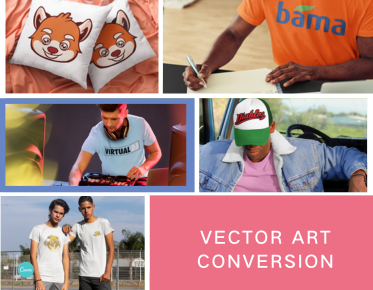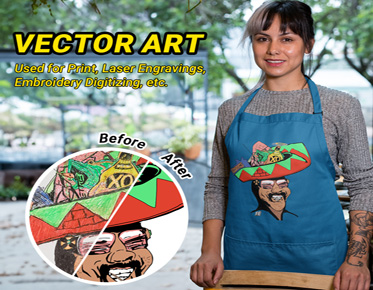Is Raster Art or Vector Art Better for Design Needs?
In the world of digital design,
understanding the difference between vector and raster art is crucial. These two distinct formats
are the building blocks of most digital artwork, each offering unique strengths and
applications. Whether you’re crafting a sleek company logo or editing a
detailed photograph, choosing the right format can make all the difference.
Let’s dive into the essentials of vector and raster art, explore their
characteristics, and find out which is best suited for your design needs.
Understanding
the Basics of Vector and Raster Art
Both vector and
raster art serve specific purposes in graphic design, but they differ
fundamentally in how they are created and utilized. Vector art relies on
mathematical equations, while raster art is composed of tiny pixels. These core
differences affect everything from scalability to file size, and understanding
them will help you make informed choices for your projects.
Why
Choosing the Right Art Type Matters for Your Design Projects
Selecting the correct format is more than
a technical decision; it’s about aligning your tools with your creative vision.
Whether you're aiming for crisp, scalable designs or intricate, photo-realistic
images, choosing the wrong type can limit your design’s potential, compromise quality,
and even affect the final output in printing or digital display.
What
is Vector Art?
Defining
Vector Art: The Math Behind the Magic
Digital graphics composed on pathways
determined by mathematical formulas are known as vector art. Each path, which
consists of points and curves, is based on mathematical expressions. This means
that no matter how much you scale a vector image up or down, it retains its
crisp, clean lines. Think of it as a blueprint for your design, providing
precise control over shapes and lines.
How
Vector Art Creates Clean and Crisp Designs
The mathematical nature of vector art
ensures that every curve and line is perfectly smooth, no matter the size. This
is why vector graphics are often used for logos,
icons, and other graphics that need to be versatile across different sizes and
resolutions. It’s like having an infinitely scalable template, making it ideal
for branding and illustrations.
Common
Uses for Vector Art in Graphic Design
Vector art is the go-to choice for any
design work that requires high scalability. It’s commonly used in logo design,
icons, typography, and infographics. Because vectors can be resized without
losing quality, they are also ideal for creating items that will be printed in
various sizes, like posters, business cards, and banners.
What
is Raster Art?
Breaking
Down Raster Art: Pixels, Pixels, Pixels
Raster art, in contrast to vector art, is
composed of pixels—tiny squares of color that come together to form an image.
An image's resolution increases with the number of pixels it contains. Raster
images are incredibly detailed and are often used for photographs and complex,
shaded artwork. However, resizing them can be tricky, as scaling up can cause
pixelation, resulting in blurry or jagged edges.
How
Raster Art Achieves Detailed and Realistic Imagery
Because raster art is pixel-based, it can
capture the subtle variations in color and shading that give photographs their
realistic look. It’s perfect for images where detail and texture are key, such
as digital paintings, complex illustrations, and photographs. The pixel grid
allows for a high level of detail, making raster the preferred choice for
photo-realistic artwork.
Popular
Applications of Raster Art in Design and Photography
Raster art is the preferred format for
digital photography, web graphics, and detailed digital paintings. It’s also
widely used in web design for background images, textures, and complex graphics
that require color gradients. The pixel-based nature of raster files allows for
intricate details that can’t be easily replicated with vector formats.
The
Key Differences Between Vector and Raster Art
Scalability:
The Power of Infinite Resizing vs. Fixed Resolution
One of the biggest distinctions between
vector and raster art is scalability. Vector graphics can be resized infinitely
without any loss of quality, making them perfect for designs that need to be
scaled up or down frequently. Raster images, on the other hand, have a fixed
resolution. Enlarging a raster image can lead to pixelation, where the image
appears blurry or jagged.
Resolution
Matters: Why Pixel Density Impacts Quality
Pixel density, often measured in dots per
inch (DPI), is a critical factor for raster images. High DPI means more pixels
are packed into a given area, resulting in a sharper image. Vector images don’t
rely on DPI; instead, their quality is determined by the accuracy of the
mathematical paths. This makes vectors resolution-independent and ideal for
projects requiring various sizes and formats.
Editing
Flexibility: Paths vs. Pixels and How They Shape Your Workflow
Editing vector art involves manipulating
paths and anchor points, making it easy to alter shapes and lines without
affecting the overall quality. Raster art, however, involves adjusting pixels,
which can be more challenging, especially when making significant changes. For
instance, altering a raster image's color gradient or shading often requires
more intricate adjustments than simply tweaking a vector path.
When
Should You Use Vector Art?
Perfect
for Logos and Branding: The Power of Scalability
Vector art is the preferred choice for
logos and branding because it can be resized to fit everything from a tiny
business card to a massive billboard without losing quality. This scalability
ensures that your brand's visuals remain consistent and sharp across all
mediums.
Creating
Simple Illustrations and Icons: Why Vectors Shine Here
Simple illustrations and icons are best
created in vector format because they typically involve clean lines and shapes.
Vectors allow for easy adjustments and ensure the designs can be scaled to
different sizes, making them versatile for various uses.
When
You Need Precision: Why Vector Graphics Work Best for Technical Drawings
Technical drawings, like blueprints,
schematics, and CAD designs, require the precise control offered by vector
graphics. The mathematical formulas defining vector paths allow for exact
measurements and scalable details, making them ideal for intricate, detailed
work.
When
Should You Use Raster Art?
Photography
and Digital Painting: Raster Art’s True Strength
Raster art excels in any project
requiring detailed textures and realistic shading, making it the top choice for
photography and digital painting. The pixel-based nature allows for subtle
color variations, which is crucial for lifelike imagery.
For
Complex Color Gradients and Textures, Choose Raster
When your design needs smooth gradients
or intricate textures, raster art is the better option. It handles complex
shading and color transitions more effectively than vector art, which can
struggle with creating the same level of detail and depth.
When
Realism is Key: Why Raster is Best for Detailed Artwork
If your project aims to capture a
realistic look—whether it’s a digitalpainting, a photograph, or a hyper-realistic illustration—raster is
the way to go. The ability to depict fine details and subtle variations in
color makes it unparalleled for realistic imagery.
Understanding the strengths and limitations of both vector and raster art is essential for any designer. Each has its unique applications and is suited for different types of projects. By mastering both, you can make informed decisions, ensuring your designs are not only visually stunning but also technically sound. The key is to choose the format that best aligns with your creative vision and project requirements, setting the stage for successful and impactful designs.


.png)
